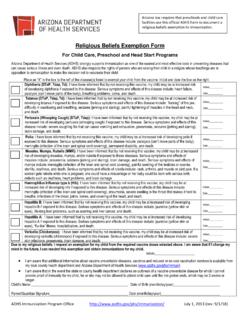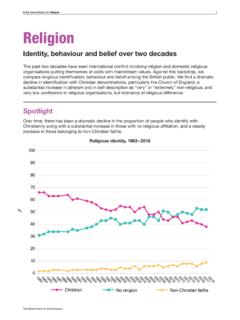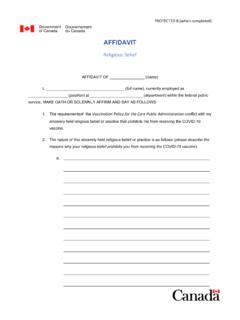Transcription of Oxford Cambridge and RSA A Level Religious Studies
1 OCR 2016 H573/01 Turn over QN:601/8868/6 D10114/14 Oxford Cambridge and RSA A Level Religious Studies H573/01 Philosophy of religion Sample Question Paper Date Morning/Afternoon Time allowed: 2 hours You must have: The OCR 16 page Answer Booklet. INSTRUCTIONS Use black ink. Answer three questions. Write your answer to each question in the answer booklet provided. Do not write in the bar codes. INFORMATION The total mark for this paper is 120. The marks for each question are shown in brackets [ ]. All questions on this paper require an extended response. This document consists of 4 pages. Quality of extended responses will be assessed in questions marked with an asterisk (*). SPECIMEN2 OCR 2016 H573/01 Answer any three questions. In all your responses, you should: demonstrate knowledge and understanding of religion and belief , including knowledge and understanding of Religious thought and teaching approaches to the study of religion and belief .
2 Analyse and evaluate aspects of, and approaches to, religion and belief , including their significance, influence and study. 1* To what extent is the ontological argument successful in proving the existence of God? [40] 2* Religious experience shows that we can be united with something greater than ourselves. Discuss. [40] 3* Evaluate the view that the thinking mind is separate from the body. [40] 4* Critically compare the via negativa with symbolic language as ways of expressing Religious beliefs in words. [40] SPECIMEN3 OCR 2016 H573/01 BLANK PAGE SPECIMEN4 OCR 2016 H573/01 Copyright Information: OCR is committed to seeking permission to reproduce all third-party content that it uses in the assessment materials.
3 OCR has attempted to identify and contact all copyright holders whose work is used in this paper. To avoid the issue of disclosure of answer-related information to candidates, all copyright acknowledgements are reproduced in the OCR Copyright Acknowledgements booklet. This is produced for each series of examinations and is freely available to download from our public website ( ) after the live examination series. If OCR has unwittingly failed to correctly acknowledge or clear any third-party content in this assessment material, OCR will be happy to correct its mistake at the earliest possible opportunity. For queries or further information please contact the Copyright Team, First Floor, 9 Hills Road, Cambridge CB2 1GE. OCR is part of the Cambridge Assessment Group; Cambridge Assessment is the brand name of University of Cambridge Local Examinations Syndicate (UCLES), which is itself a department of the University of D10114/14.
4 Day June 20XX Morning/Afternoon A Level Religious Studies H573/01 Philosophy of religion SAMPLE MARK SCHEME Duration: 2 hours MAXIMUM MARK 120 This document consists of 18 pages SPECIMENH573/01 Mark Scheme June 20XX 2 MARKING INSTRUCTIONS PREPARATION FOR MARKING ON SCORIS 1. Make sure that you have accessed and completed the relevant training packages for on-screen marking: Scoris Assessor Online Training; OCR Essential Guide to Marking. 2. Make sure that you have read and understood the mark scheme and the question paper for this unit. These are posted on the RM Cambridge Assessment Support Portal 3. Log-in to Scoris and mark the required number of practice responses ( scripts ) and the required number of standardisation responses. YOU MUST MARK 10 PRACTICE AND 10 STANDARDISATION RESPONSES BEFORE YOU CAN BE APPROVED TO MARK LIVE SCRIPTS.
5 MARKING 1. Mark strictly to the mark scheme. 2. Marks awarded must relate directly to the marking criteria. 3. The schedule of dates is very important. It is essential that you meet the Scoris 50% and 100% (traditional 50% Batch 1 and 100% Batch 2) deadlines. If you experience problems, you must contact your Team Leader (Supervisor) without delay. 4. If you are in any doubt about applying the mark scheme, consult your Team Leader by telephone, email or via the Scoris messaging system. 5. Work crossed out: a. where a candidate crosses out an answer and provides an alternative response, the crossed out response is not marked and gains no marks b. if a candidate crosses out an answer to a whole question and makes no second attempt, and if the inclusion of the answer does not cause a rubric infringement, the assessor should attempt to mark the crossed out answer and award marks appropriately.
6 6. Always check the pages (and additional objects if present) at the end of the response in case any answers have been continued there. If the candidate has continued an answer there then add a tick to confirm that the work has been seen. 7. There is a NR (No Response) option. Award NR (No Response) if: there is nothing written at all in the answer space OR there is a comment that does not in any way relate to the question ( can t do , don t know ) OR there is a mark ( a dash, a question mark) that is not an attempt at the question. Note: Award 0 marks for an attempt that earns no credit (including copying out the question). 8. The Scoris comments box is used by your Team Leader to explain the marking of the practice responses. Please refer to these comments when checking your practice responses.
7 Do not use the comments box for any other reason. If you have any questions or comments for your Team Leader, use the phone, the Scoris messaging system, or e-mail. 9. Assistant Examiners will send a brief report on the performance of candidates to their Team Leader (Supervisor) via email by the end of the marking period. The report should contain notes on particular strengths displayed as well as common errors or weaknesses. Constructive criticism of the question paper/mark scheme is also appreciated. SPECIMENH573/01 Mark Scheme June 20XX 3 SUBJECT SPECIFIC MARKING INSTRUCTIONS Introduction Your first task as an Examiner is to become thoroughly familiar with the material on which the examination depends. You should ensure that you have copies of these materials: the specification, especially the assessment objectives the question paper and its rubrics the mark scheme.
8 You should ensure also that you are familiar with the administrative procedures related to the marking process. These are set out in the OCR booklet Instructions for Examiners. If you are examining for the first time, please read carefully Appendix 5 Introduction to Script Marking: Notes for New Examiners. Please ask for help or guidance whenever you need it. Your first point of contact is your Team Leader. Information and instructions for examiners The co-ordination scripts provide you with examples of the standard of each band. The marks awarded for these scripts will have been agreed by the Team Leaders and will be discussed fully at the Examiners Co-ordination Meeting. The specific task-related indicative content for each question will help you to understand how the band descriptors may be applied. However, this indicative content does not constitute the mark scheme: it is material that candidates might use, grouped according to each assessment objective tested by the question.
9 It is hoped that candidates will respond to questions in a variety of ways. Rigid demands for what must be a good answer would lead to a distorted assessment. Candidates answers must be relevant to the question. Beware of prepared answers that do not show the candidate s thought and which have not been adapted to the thrust of the question. Beware also of answers where candidates attempt to reproduce interpretations and concepts that they have been taught but have only partially understood. SPECIMENH573/01 Mark Scheme June 20XX 4 Using the Mark Scheme Please study this Mark Scheme carefully. The Mark Scheme is an integral part of the process that begins with the setting of the question paper and ends with the awarding of grades. Question papers and Mark Schemes are developed in association with each other so that issues of differentiation and positive achievement can be addressed from the very start.
10 This Mark Scheme is a working document; it is not exhaustive; it does not provide correct answers. The Mark Scheme can only provide best guesses about how the question will work out, and it is subject to revision after we have looked at a wide range of scripts. The Examiners Standardisation Meeting will ensure that the Mark Scheme covers the range of candidates responses to the questions, and that all Examiners understand and apply the Mark Scheme in the same way. The Mark Scheme will be discussed and amended at the meeting, and administrative procedures will be confirmed. Co-ordination scripts will be issued at the meeting to exemplify aspects of candidates responses and achievements; the co-ordination scripts then become part of this Mark Scheme. Before the Standardisation Meeting, you should read and mark in pencil a number of scripts, in order to gain an impression of the range of responses and achievement that may be expected.














